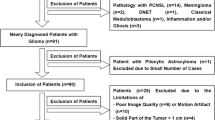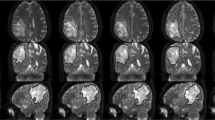Abstract
This study was to evaluate the diagnostic performance of fractional anisotropy (FA) and apparent diffusion coefficient (ADC) parameters derived from diffusion tensor imaging in the differentiation between grade II and III gliomas. The records of 60 patients (30 women, 30 men; mean age, 45.4 years) suspected of having gliomas who underwent an ADC image-guided stereotactic biopsy were retrospectively reviewed. The values of FA and ADC were measured, and the sensitivity, specificity, accuracy and area under the curve (AUC) of those parameters were calculated based on the receiver operating characteristic curve analysis. A predictive diagnostic equation was also constructed and evaluated. Significant differences in minimum ADC values were found in the quantitative analysis between the grade III and II glioma groups. The sensitivity, specificity, positive predictive values (PPV), negative predictive values (NPV), accuracy and AUC for identifying grade III and II gliomas at the optimum cut-off value of 0.895 × 10−3 mm2/s of minimum ADC were 81.0, 89.1, 77.3, 91.1, 86.6 and 0.87, respectively. The predictive diagnostic equation was superior to the single minimum ADC indicator with a sensitivity of 90.5%, a specificity of 84.8%, a PPV of 73.1%, an NPV of 95.1%, and an accuracy of 86.6%, respectively. The study provides evidence that minimum ADC values have a superior diagnostic performance in differentiating grade III and II gliomas, and the predictive diagnostic equation may be helpful in the differentiation.


Similar content being viewed by others
Abbreviations
- ADC:
-
Apparent diffusion coefficient
- AU:
-
Arbitrary unit
- AUC:
-
Area under the curve
- CI:
-
Confidence intervals
- DTI:
-
Diffusion tensor imaging
- DWI:
-
Diffusion-weighted imaging
- FA:
-
Fractional anisotropy
- FN:
-
False negative
- FP:
-
False positive
- HGG:
-
High-grade glioma
- LGG:
-
Low-grade glioma
- MRI:
-
Magnetic resonance imaging
- MRS:
-
Magnetic resonance spectroscopy
- NOS:
-
Not otherwise specified
- NPV:
-
Negative predictive values
- PPV:
-
Positive predictive values
- ROC:
-
Receiver operating characteristic curve
- SD:
-
Standard deviation
- SEN:
-
Sensitivity
- SPE:
-
Specificity
- TN:
-
True negative
- TP:
-
True positive
References
Inoue T, Ogasawara K, Beppu T, Ogawa A, Kabasawa H (2005) Diffusion tensor imaging for preoperative evaluation of tumor grade in gliomas. Clin Neurol Neurosurg 107:174–180
Sugahara T, Korogi Y, Kochi M et al (1999) Usefulness of diffusion-weighted MRI with echo-planar technique in the evaluation of cellularity in gliomas. J Magn Reson Imaging 9:53–60
Essig M, Anzalone N, Combs SE et al (2012) MR imaging of neoplastic central nervous system lesions: review and recommendations for current practice. AJNR Am J Neuroradiol 33:803–817
Chung C, Metser U, Ménard C (2015) Advances in magnetic resonance imaging and positron emission tomography imaging for grading and molecular characterization of glioma. Semin Radiat Oncol 25:164–171
Pierpaoli C, Basser PJ (1996) Toward a quantitative assessment of diffusion anisotropy. Magn Reson Med 36:893–906
Tien RD, Felsberg GJ, Friedman H, Brown M, MacFall J (1994) MR imaging of high-grade cerebral gliomas: value of diffusion-weighted echoplanar pulse sequences. AJR Am J Roentgenol 162:671–677
Kono K, Inoue Y, Nakayama K et al (2001) The role of diffusion-weighted imaging in patients with brain tumors. AJNR Am J Neuroradiol 22:1081–1088
Chen J, Xia J, Zhou YC et al (2005) Correlation between magnetic resonance diffusion weighted imaging and cell density in astrocytoma. Zhonghua Zhong Liu Za Zhi 27:309–311
Zhang L, Min Z, Tang M, Chen S, Lei X, Zhang X (2017) The utility of diffusion MRI with quantitative ADC measurements for differentiating high-grade from low-grade cerebral gliomas: evidence from a meta-analysis. J Neurol Sci 373:9–15
Chen X, Xu BN, Meng X, Zhang J, Yu X, Zhou D (2012) Dual-room 1.5-T intraoperative magnetic resonance imaging suite with a movable magnet: implementation and preliminary experience. Neurosurg Rev 35:95–109
Stadlbauer A, Gruber S, Nimsky C et al (2006) Preoperative grading of gliomas by using metabolite quantification with high-spatial-resolution proton MR spectroscopic imaging. Radiology 238:958–969
Zhang JS, Chen XL, Li FY et al (2012) Implementation of VarioGuide in stereotactic brain biopsy: a preliminary experience. Zhonghua Yi Xue Za Zhi 92:1468–1471
Zweig MH, Campbell G (1993) Receiver-operating characteristic (ROC) plots: a fundamental evaluation tool in clinical medicine. Clin Chem 39:561–577
Hanley JA, McNeil BJ (1983) A method of comparing the areas under receiver operating characteristic curves derived from the same cases. Radiology 148:839–843
Fudaba H, Shimomura T, Abe T et al (2014) Comparison of multiple parameters obtained on 3T pulsed arterial spin-labeling, diffusion tensor imaging, and MRS and the Ki-67 labeling index in evaluating glioma grading. AJNR Am J Neuroradiol 35:2091–2098
Lee EJ, Lee SK, Agid R, Bae JM, Keller A, Terbrugge K (2008) Preoperative grading of presumptive low-grade astrocytomas on MR imaging: diagnostic value of minimum apparent diffusion coefficient. AJNR Am J Neuroradiol 29:1872–1877
Server A, Kulle B, Gadmar ØB, Josefsen R, Kumar T, Nakstad PH (2011) Measurements of diagnostic examination performance using quantitative apparent diffusion coefficient and proton MR spectroscopic imaging in the preoperative evaluation of tumor grade in cerebral gliomas. Eur J Radiol 80:462–470
Chen Z, Ma L, Lou X, Zhou Z (2010) Diagnostic value of minimum apparent diffusion coefficient values in prediction of neuroepithelial tumor grading. J Magn Reson Imaging 31:1331–1338
Murakami R, Hirai T, Sugahara T et al (2009) Grading astrocytic tumors by using apparent diffusion coefficient parameters: superiority of a one- versus two-parameter pilot method. Radiology 251:838–845
Arevalo-Perez J, Peck KK, Young RJ, Holodny AI, Karimi S, Lyo JK (2015) Dynamic contrast-enhanced perfusion MRI and diffusion-weighted imaging in grading of gliomas. J Neuroimaging 25:792–798
Weber MA, Henze M, Tüttenberg J et al (2010) Biopsy targeting gliomas: do functional imaging techniques identify similar target areas. Invest Radiol 45:755–768
Khayal IS, Crawford FW, Saraswathy S et al (2008) Relationship between choline and apparent diffusion coefficient in patients with gliomas. J Magn Reson Imaging 27:718–725
Turkbey B, Xu S, Kruecker J et al (2011) Documenting the location of systematic transrectal ultrasound-guided prostate biopsies: correlation with multi-parametric MRI. Cancer Imaging 11:31–36
Somford DM, Hoeks CM, de Kaa CAH et al (2013) Evaluation of diffusion-weighted MR imaging at inclusion in an active surveillance protocol for low-risk prostate cancer. Invest Radiol 48:152–157
Shinmoto H, Tamura C, Soga S, Okamura T, Horiguchi A, Asano T, Kaji T (2015) Anterior prostate cancer: diagnostic performance of T2-weighted MRI and an apparent diffusion coefficient Map. AJR Am J Roentgenol 205:W185–W192
Zakaria R, Jenkinson MD (2014) Using ADC maps with structural scans to improve intraoperative biopsy specimens in brain metastases. Neuroradiol J 27:422–424
Wieshmann UC, Clark CA, Symms MR, Franconi F, Barker GJ, Shorvon SD (1999) Reduced anisotropy of water diffusion in structural cerebral abnormalities demonstrated with diffusion tensor imaging. Magn Reson Imaging 17:1269–1274
Yang D, Korogi Y, Sugahara T et al (2002) Cerebral gliomas: prospective comparison of multivoxel 2D chemical-shift imaging proton MR spectroscopy, echoplanar perfusion and diffusion-weighted MRI. Neuroradiology 44:656–666
Rollin N, Guyotat J, Streichenberger N, Honnorat J, Tran MVA, Cotton F (2006) Clinical relevance of diffusion and perfusion magnetic resonance imaging in assessing intra-axial brain tumors. Neuroradiology 48:150–159
Lam WW, Poon WS, Metreweli C (2002) Diffusion MR imaging in glioma: does it have any role in the pre-operation determination of grading of glioma. Clin Radiol 57:219–225
Acknowledgements
The scientific guarantor of this publication is Xiaolei Chen, PHD. The authors of this manuscript declare no relationships with any companies, whose products or services may be related to the subject matter of the article. This study has received funding by Hospital Young Doctor Funding Plan of Chinese PLA General Hospital (Grant Number 15KMM19), Hospital Clinical Sponsor Foundation Plan of Chinese PLA General Hospital (Grant Number 2016FC-TSYS-1023). One of the authors (Xinghua Xu) has significant statistical expertise. Institutional review board approval and written informed consent were obtained.
Author information
Authors and Affiliations
Corresponding authors
Ethics declarations
Conflict of interest
The authors declare that they have no conflict of interest.
Rights and permissions
About this article
Cite this article
Wang, Q., Zhang, J., Xu, X. et al. Diagnostic performance of apparent diffusion coefficient parameters for glioma grading. J Neurooncol 139, 61–68 (2018). https://doi.org/10.1007/s11060-018-2841-5
Received:
Accepted:
Published:
Issue Date:
DOI: https://doi.org/10.1007/s11060-018-2841-5




